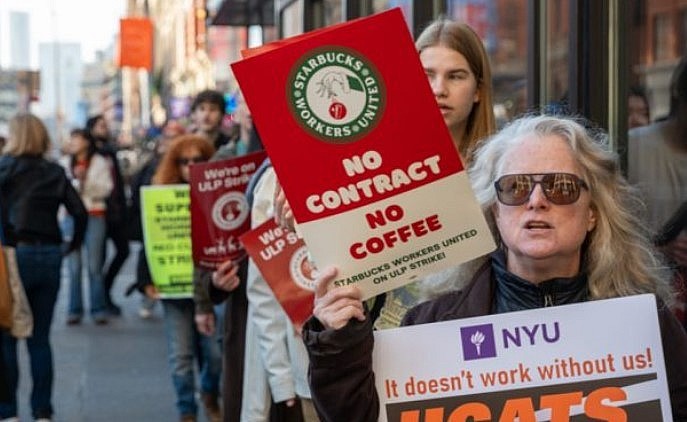Starbucks Strike Across 43 States: Barista's $15.49 Vs. CEO's $50,000 an Hour
 |
| Starbucks is on the cusp of a major barista strike |
The holiday season took on a striking tone this year as more than 5,000 Starbucks baristas across 43 states walked out in protest. For five days, over 300 locations were shuttered, disrupting business at one of the busiest times of the year for the coffee giant. This large-scale strike brought attention to the growing divide between the company’s promises of investment in its workers and the realities of wage disparities, particularly when juxtaposed against the $50,000-an-hour compensation of its CEO.
The Catalyst for the Strike
The strike stemmed from stalled negotiations between Starbucks Workers United, the union representing thousands of baristas, and the corporate management. At the heart of the dispute were pay, staffing, and scheduling issues. The union argued that Starbucks failed to honor earlier commitments to improve collective bargaining and resolve legal disputes.
Baristas have long expressed concerns over stagnant wages and the increasing cost of living. According to the union, Starbucks proposed an economic package that included no immediate wage increases for unionized baristas and guaranteed only a 1.5% annual increase in the coming years—a raise of less than 50 cents per hour.
Barista Michelle Eisen, a bargaining delegate, highlighted the union’s frustration, stating, "This is backtracking on months and months of progress and promises from the company to work toward an end-of-year framework ratification." With no meaningful negotiations since October, the union decided to take action.
Pay Disparities: Baristas vs. CEO
The stark contrast between the wages of baristas and Starbucks executives became a focal point during the strike. Lauren Hollingsworth, a barista earning $15.49 per hour, contrasted her pay with the over $50,000-an-hour compensation of Starbucks CEO Brian Niccol, whose package was valued at $113 million in 2023.
Hollingsworth noted that many of her colleagues are forced to commute long distances to work because they cannot afford housing closer to their stores. “My coworkers and I made the difficult decision to launch unfair labor practice strikes in hundreds of stores across the country because we know that investing in baristas is the only way to turn things around,” she said.
The union argues that Starbucks has the financial capacity to offer higher wages and benefits to its frontline workers. These workers, they claim, are the backbone of the company’s success.
Starbucks’ Position
Starbucks responded to the strike by emphasizing its commitment to reaching an agreement with the union. Sara Kelley, the executive vice president and chief partner officer, stated that the company had made significant progress in negotiations. According to Kelley, Starbucks held over nine bargaining sessions across 20 days since April, resulting in 30 agreements on various issues, including economic terms.
However, Kelley criticized the union’s demands, describing them as unsustainable. “Workers United proposals call for an immediate increase in the minimum wage of hourly partners by 64%, and by 77% over the life of a three-year contract,” she wrote in an open letter. Kelley added that Starbucks offers an average wage of more than $18 an hour, along with benefits like health care, free college tuition, paid family leave, and stock grants.
Despite these claims, baristas maintain that the proposed wage increases fall short of addressing their financial struggles, especially when compared to the company’s substantial revenues and executive compensation.
Impact on Operations
While the strike temporarily disrupted operations at over 300 locations, Starbucks downplayed its overall impact. Kelley stated that more than 10,000 company-operated stores remained open during the strike, with about 97% to 99% of stores operating as usual.
However, the timing of the strike—just days before Christmas—amplified its significance. The final days of the holiday season are typically among the busiest for Starbucks, and the strike served as a strategic move to pressure the company during a peak period.
A Growing Movement
The strike is part of a broader movement among Starbucks workers to unionize and advocate for better working conditions. Since December 2021, more than 520 Starbucks locations have unionized, with more stores filing petitions with the National Labor Relations Board. Baristas at a Starbucks on Sunset Boulevard and La Brea Avenue were among the latest to seek unionization during the strike, underscoring the momentum of the labor movement within the company.
What’s Next?
As the strike concluded, both sides expressed a willingness to return to the bargaining table. The union plans to strategize its next steps in the fight for higher wages and improved working conditions. Meanwhile, Starbucks management reiterated its readiness to negotiate but warned against demands it deems unsustainable.
The strike highlighted a growing divide in the modern labor landscape, where frontline workers are increasingly vocal about income inequality and corporate accountability. As baristas return to work, the outcome of this labor dispute could set a precedent for other companies grappling with similar issues.
Conclusion
The Starbucks strike across 43 states was not just a call for higher wages; it was a broader statement about economic justice and the value of workers in the corporate hierarchy. With the holiday season disrupted and public attention drawn to the striking wage disparity, the strike underscored the need for meaningful dialogue and action to bridge the gap between baristas and the corporate elite. Whether Starbucks can navigate this crisis and emerge with its reputation intact depends on its willingness to meet its workers’ demands halfway, proving that it values the people behind its iconic coffee cups.
 How to Make Iced Matcha Latte in Summer's Different Types With Easy Steps How to Make Iced Matcha Latte in Summer's Different Types With Easy Steps Learn how to make different iced Matcha Latte to help cool down in the hot summer: Vanilla Matcha Latte, Starbucks Recipe, Espresso and 2 Layers ... |























